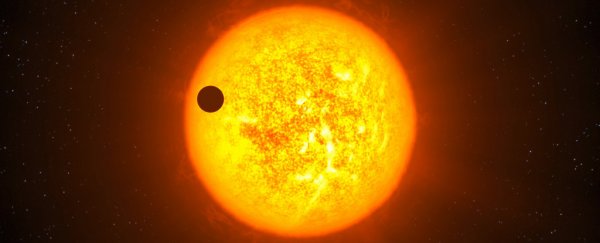Planets outside of our Solar System are rather dull things. So dull, we can only see them directly by sifting out a scattering of reflected rays amid the glare of their parent star. Even then, the best we can manage is a pinprick to identify its position.
Gathering enough light to reveal intricate details of these distant worlds would require a lens far larger than anything we can construct. One wider than Earth. Wider than Jupiter, in fact.
Fortunately, cosmic-scale lenses happen to exist already. Thanks to the way that mass dimples the fabric of space, heavy objects like our own Sun can serve as cosmic-scale telescopes.
It's not just theoretical. So-called gravitational lensing was first demonstrated more than a century ago and has since been used to push the limits on how far into the Universe we can see.
But using our own star's roiling mass to unveil delicate shifts in coloration and pattern of an exoplanet's surface – that's a whole other story.
In 2020, a California Institute of Technology physicist by the name of Slava Turyshev proposed a technique whereby scanning light bending around a planet could be resolved into some kind of image.
Achieving this would require a spacecraft that could cover a vast area of space, something that would push the limits on materials, fuel, and speed of current technology.
Starting with Turyshev's idea, two physicists from Stanford University in the US have now proposed a new method for making use of the Sun's space-distorting mass as a way to focus the faint light from exoplanets into a meaningful image.
While their method instead relies on sending a Hubble-sized space observatory into the frozen outlands of our Solar System, the algorithm for weaving the light funneled into a ring around the Sun into a clear picture requires just a single snapshot of light.
To test the idea, the researchers used weather satellite data of a rotating Earth, simulating it as a smeared funneling of light known as an Einstein ring. Their algorithm successfully deciphered the distorted image, recreating a clearly recognizable (if rather pixelated) world we call home.
 How Earth might look viewed using the Sun. (Madurowicz et al., ApJ, 2022)
How Earth might look viewed using the Sun. (Madurowicz et al., ApJ, 2022)
In theory, the process could result in images of far-off objects 1,000 times more precise than anything we can hope for using modern technology.
"We want to take pictures of planets that are orbiting other stars that are as good as the pictures we can make of planets in our own Solar System," says physicist Bruce Macintosh.
"With this technology, we hope to take a picture of a planet 100 light-years away that has the same impact as Apollo 8's picture of Earth."
Since the first exoplanet's discovery in the early 1990s, astronomers have uncovered signs of more than 5,000 worlds orbiting stars in the Milky Way (and maybe beyond).
Those signs are the equivalent of hearing footsteps in the darkness, however. We can deduce how big the planet is, and how fast it might be moving. We might even sift out a few details on the composition of its atmosphere and its temperature.
The rest is left up to our imagination, inspired by the characteristics of planets making up our own Solar System.
Yet, resolving features of clouds, oceans, mineral deposits, and even chasms and mountains in exoplanets could tell us so much more about commonalities of geological features throughout the Universe – including the potential for alien biology.
"By taking a picture of another planet, you could look at it and possibly see green swatches that are forests and blue blotches that are oceans – with that, it would be hard to argue that it doesn't have life," says Macintosh.
The biggest obstacle to employing this particular technique is the journey such an observatory would need to make.
Right now, the Voyager 1 probe is the most distant human-created object ever to venture into the cold darkness of the outer Solar System. Launched in 1977, it has since covered an astonishing 23 billion kilometers (14.5 billion miles). That's 156 times the gap between Earth and the Sun.
The destination required for an exoplanet-spying telescope that uses the Sun as a lens is more than four times that record-breaking distance, a trip that would take at least a century to make using all of our present know-how.
Innovative solutions to long-distance space travel might get us there sooner, of course. Meaning it's possible an exoplanet-spying cosmic telescope might yet have its day in the Sun.
This research was published in The Astrophysical Journal.
